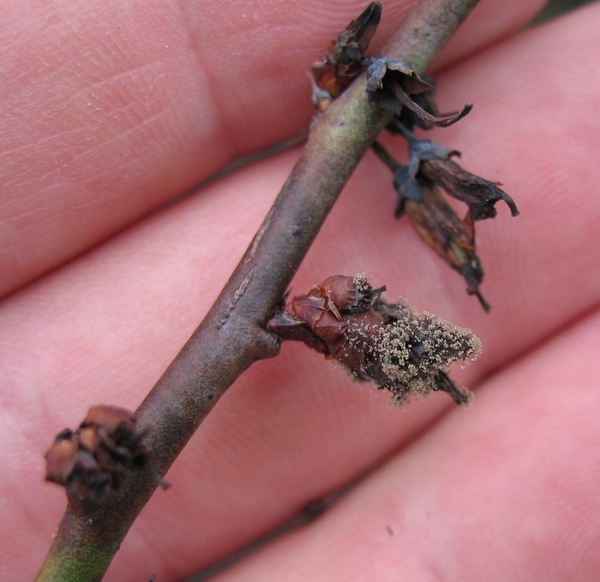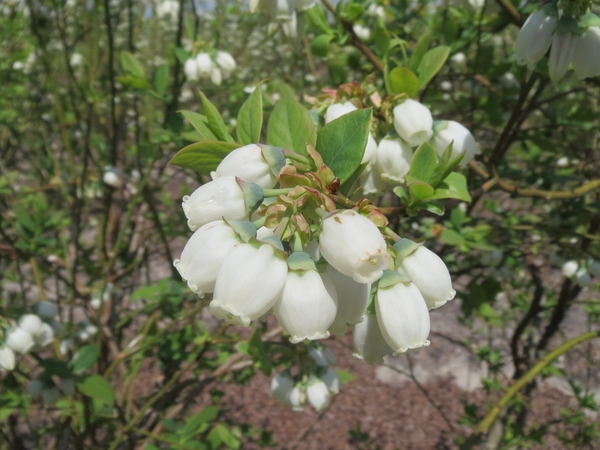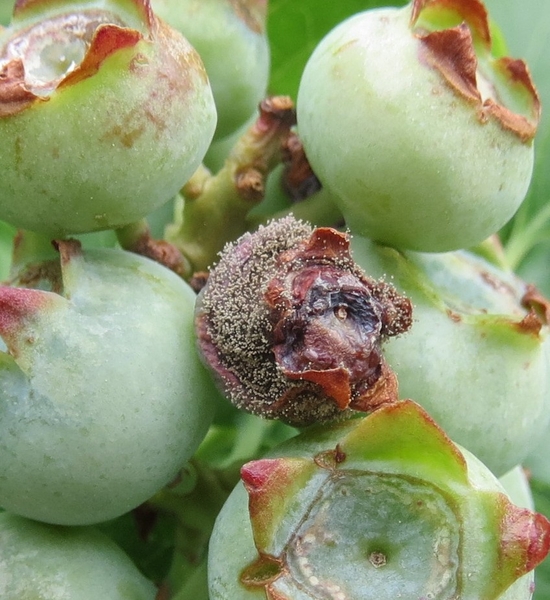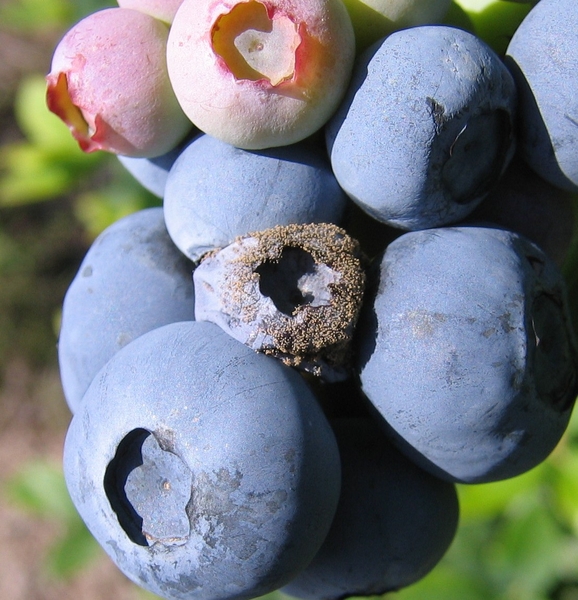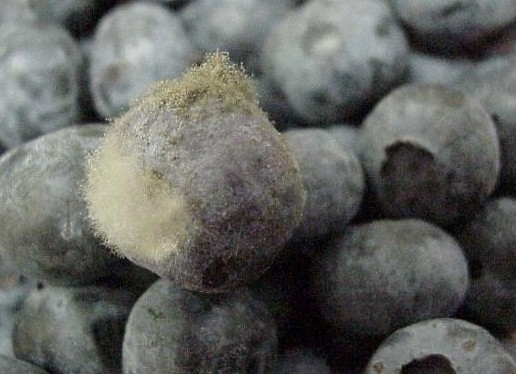Introduction
Botrytis species are some of the most common and recognizable plant pathogens. Anyone who has let their produce sit out too long has likely seen it become enveloped by a characteristic fuzzy gray-tan growth that gives Botrytis infections their common name—"Gray mold". On blueberries, Botrytis cinerea causes a blossom blight and fruit rot that can be devastating in some years and on certain cultivars. In North Carolina, Gray mold is mostly an issue of rabbiteye cultivars and typically develops after freeze damage to the blooms. The blight stage of the disease begins during bloom and can infect blossoms, tender twigs, and young leaves. These infections can girdle the stem and kill all tissues above it. Persistent rainy and wet weather during bloom can exacerbate damage levels from botrytis blight. While not as devastating as the blossom blight in North Carolina, Botrytis can infect the fruit at any stage to cause a rot, but symptoms typically don't appear until after harvest.
Symptoms and signs
Botrytis blight often begins on blossoms after pollination but before flower drop. As the flowers are colonized and killed by the pathogen, they turn a brown color instead of their typical white. The pathogen spreads from the flowers down the peduncle and eventually to the tender stems, killing all above flowers and fruit. The infected blossoms turn from brown-black to gray in color before the characteristic gray-tan mold forms. These blossoms often stay on the bush after fruit set—one of the important diagnostic features. However, these brown-black blossoms staying on the bush may be confused with frost damage or Phomopsis twig blight. The gray mold and spore clusters are a good diagnostic sign to differentiate Botrytis from other types of blossom damage. If disease is severe, losses come from a reduction in berries due to the many destroyed blooms. Infected blossoms can serve as a source of inoculum for fruit throughout all stages, but symptoms often don't arise until after harvest. In North Carolina, the fruit rot stage of Botrytis infections is infrequent and often not as devastating as blossom blight.
Disease Cycle
Botrytis spp. can overwinter as sclerotia (a compact mass of mycelium and food reserves) or as mycelium on plant debris from many hosts. These structures reactivate in the spring, producing large conidial (spore) masses that spread quickly by the wind. These spores land on susceptible tissues like blossoms and tender new twigs. Wounded or senescent tissues are especially susceptible to infection by Botrytis spp. In North Carolina, blossoms damaged by frost are the most common infection court as they stay on the plant for an extended period of time—giving the fungus plenty of dead or dying tissue to colonize. Ideal conditions for the germination of conidia are temperatures between 68-77°F and high relative humidity. Infection can take place at lower temperatures (60-68°C), but requires extended periods (3-4 days for open flowers and 6-9 days for dormant buds) of high relative humidity. Once a flower has been infected, the fungus can spread down to the peduncle and kill everything above it. During periods of high relative humidity these infected tissues will produce conidia to cause secondary infections in the field. Developing fruit are at risk of infection until infected flowers drop off. These dead flowers and other infected tissues become the overwintering sites for infection in following seasons. Fruit rot symptoms stay dormant until after harvest, but under conducive storage conditions (cool and humid) the characteristic fuzzy gray growth and spores masses are produced and infect all surrounding berries. Unlike other fruit rot pathogens, Botrytis spp. will still cause disease even at temperatures recommended for proper cold storage (~35°F).
Management
Botrytis spp. are ubiquitous in the environment, and some level of infection—especially on dead and dying tissues—will likely always be present in the environment. However, severe Botrytis blossom blight of blueberries often doesn't appear in North Carolina unless conditions are conducive and integrated management practices are effective in controlling infections. The combination of proper cultivar selection, cultural practices, fungicides, and proper harvesting practices are important and effective methods for managing Botrytis blossom blight and fruit rot.
Cultivar Selection
In North Carolina, Botrytis blossom blight is typically an issue of rabbiteye varieties—especially powderblue and tifblue—and of less importance on southern highbush. Planting more tolerant cultivars is recommended to limit the potential of disease development. Avoid planting tifblue and powderblue when selecting rabbiteye blueberries. Varieties that drop blooms quickly are often more tolerant to Botrytis blossom blight.
Cultural Practices
Annual pruning, wide row spacing, and controlling weeds can help improve airflow and prevent moisture development in the canopies and rows. As Botrytis spp. are excellent necrotrophs (decomposers), removing dead material like leaves, twigs, and canes in the offseason can be helpful for control. Avoiding low areas in the field can help prevent frost damage, which can contribute to infection levels. Overusing nitrogen fertilizer in springtime leads to new succulent twigs that are susceptible to infection and should be avoided. Timely harvest and removing all ripe fruit are important to prevent potential post-harvest losses to Botrytis and other fruit rots. Quickly cooling harvested berries to ~35°C will slow down development of post-harvest rots, as well. However, since Botrytis spp. are able to grow at temperatures slightly above freezing, management in the field is most effective.
Fungicides
Applying fungicides during bloom is key for the management of blossom blight. This is especially true if there was a freeze event. Fungicide sprays during fruit development can sometimes be helpful if blossom blight has been established, but are not as effective as sprays during bloom. See the North Carolina Agricultural Chemicals Manual for specific recommendations. Remember to rotate fungicides to prevent resistance and maintain long-term control of fungal pathogens.
Publication date: March 12, 2025
N.C. Cooperative Extension prohibits discrimination and harassment regardless of age, color, disability, family and marital status, gender identity, national origin, political beliefs, race, religion, sex (including pregnancy), sexual orientation and veteran status.

